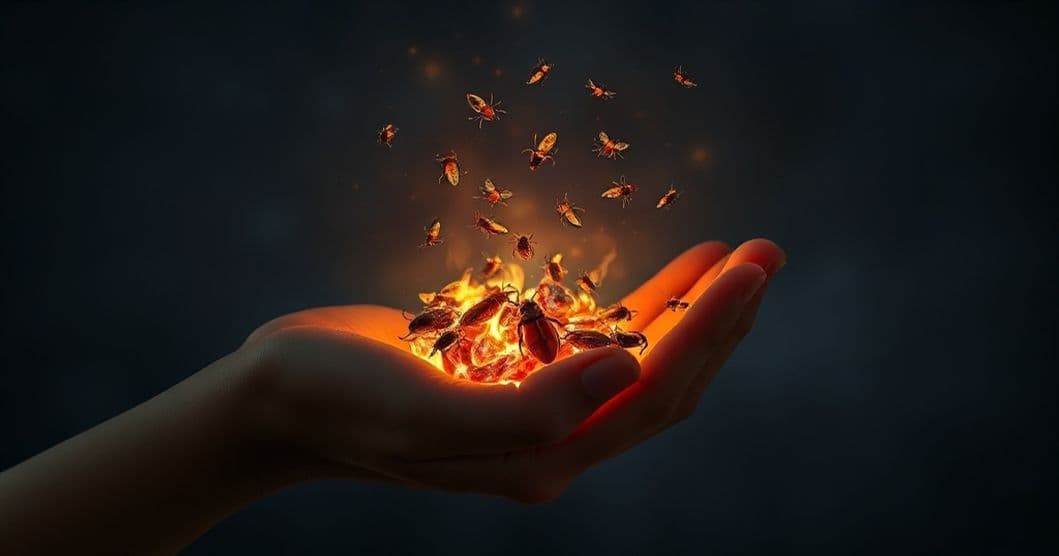Core Symbols: The Microcosm and the Macrocosm
Bugs in dreams rarely appear randomly—they’re often messengers of the 'invisible work' your subconscious is tracking. In this dream, cradling bugs suggests intentionality: you’re not just observing life’s small details but actively holding space for them. Bugs, with their intricate social structures and transformative life cycles, symbolize interconnectedness and quiet resilience. A beetle’s slow crawl might reflect patience, while a swarm could hint at collective energy you’re part of. Embers, glowing but not fully alight, represent smoldering emotions or passions that haven’t yet burned bright enough to be seen. They’re the 'warmth beneath the surface'—residues of past experiences or dreams that still pulse with potential. When you cradle these embers, you’re tending to something fragile but alive.
The constellations and their hum add a layer of cosmic significance. Constellations are human-made patterns from scattered stars—a metaphor for how you organize meaning from chaos. The 'humming' isn’t just sound; it’s the subconscious’s way of 'singing' these patterns into coherence, suggesting your mind is processing fragmented emotions into a unified narrative. Together, bugs, embers, and constellations create a visual poem: tiny, overlooked elements (bugs) nurtured with care (cradling), glowing with residual energy (embers), and arranged into something larger than themselves (constellations).
Psychology Lens: Nurturing the Unseen Self
Want a More Personalized Interpretation?
Get your own AI-powered dream analysis tailored specifically to your dream
🔮Try Dream Analysis FreeFrom a Jungian perspective, this dream might reflect the 'shadow work' of integrating overlooked parts of your psyche—the 'small' aspects you’ve neglected. The bugs could be archetypal 'anima/animus' figures, representing your feminine or masculine inner qualities needing attention. Freud might frame embers as repressed desires or unprocessed grief, while the cradle becomes a symbolic attempt to 'hold' these emotions rather than let them burn out. But modern psychology offers a richer context: during REM sleep, the brain’s default mode network activates, weaving emotional memories into stories that mirror waking life’s unspoken tensions.
Neuroscience adds another layer: the amygdala processes fear, but in dreams, it’s often recontextualized. If bugs feel threatening, your brain might be working through anxiety about small, persistent stressors (like a nagging to-do list). The constellations, then, could be your prefrontal cortex trying to 'map' solutions, turning chaos into structure. Cultural traditions echo this: Egyptian scarab beetles symbolized rebirth, while Indigenous bug totems honored community and transformation. In both, bugs aren’t just insects—they’re sacred messengers of life’s cyclical nature.
Life Triggers: When the Subconscious Whispers Through Small Details
This dream often surfaces during periods of transition or emotional reevaluation. If you’re nurturing a tiny project—a side hustle, a new relationship, or even a personal habit—your mind might visualize it as 'cradling bugs': the slow, steady work that feels invisible but vital. Embers could ignite when you’re grieving a passion that’s faded (a hobby abandoned, a friendship frayed) but still holds warmth. The constellations hum when you’re seeking purpose in daily routines, turning mundane tasks into something meaningful.
Modern life amplifies this tension: we’re bombarded with 'big wins' and pressured to see only the grand narrative. This dream becomes a counterpoint, urging you to honor the 'small things' that sustain you. Maybe you’ve been ignoring a creative impulse (bugs as the idea), a friendship that needs repair (embers as the relationship’s residual warmth), or a personal boundary that’s fraying (constellations as the structure holding it together). The cradle isn’t about control—it’s about presence.
What To Do Next: From Dream to Daily Life
Start with short-term reflection: Grab a notebook and ask, 'What bugs feel like in my life right now?' Are they crawling slowly (patience needed) or swarming (overwhelm)? Note the embers’ color—red might signal passion, gold wisdom, gray unresolved sadness. The hum’s tone: is it soothing or urgent? This sensory mapping helps you decode which 'small things' your subconscious is urging you to nurture.
For medium-term experimentation, create a 'cradle space'—physical or mental. If bugs represent small projects, set aside 15 minutes daily to work on one tiny step. If embers are relationships, send a text to someone you’ve been distant from. The constellations suggest pattern recognition: notice how these small actions connect, even if they feel disconnected now.
Long-term integration means building a 'nurturing mindset'. Ask yourself: 'What would my inner cradle look like?' It might involve daily rituals of presence—mindfully tending to plants, listening to a friend, or revisiting a forgotten interest. This dream isn’t a warning; it’s a reminder that life’s most profound lessons often hide in the overlooked, the slow, and the tender.
FAQ: Navigating the Nuances
Q: What if the bugs in my dream are crawling away or biting?
A: Crawling away might signal letting go of control over a situation. Biting bugs could reflect anxiety about small, persistent stressors—your subconscious is urging you to address these irritations directly, not suppress them.
Q: Does the color of the embers matter in this dream?
A: Embers’ hue hints at emotional tone: red = passionate energy needing release, gold = wisdom from past experiences, gray = lingering sadness or uncertainty. Notice which color stands out most.
Q: Is this a sign of impending danger or something positive?
A: This dream rarely predicts danger. Instead, it reflects your current emotional state—you’re being asked to tend to overlooked parts of life, not fear the future. The 'humming constellations' suggest order is emerging from chaos.
